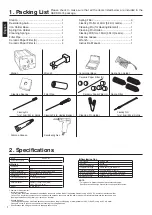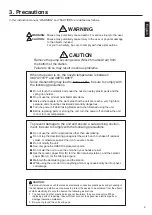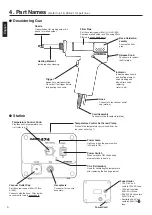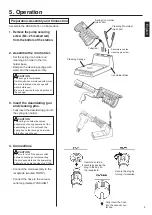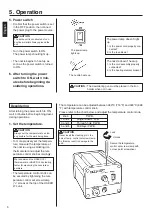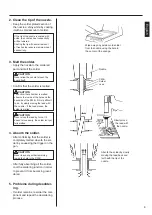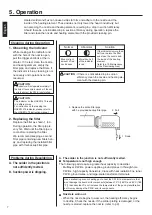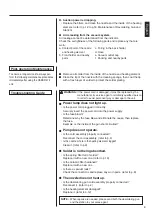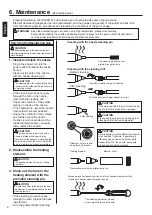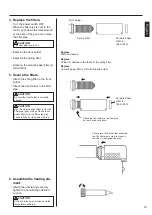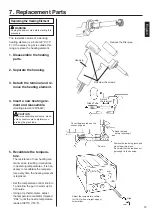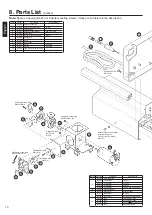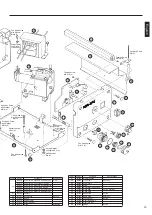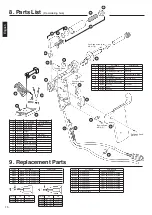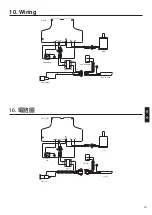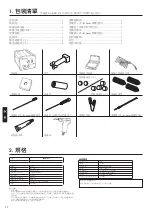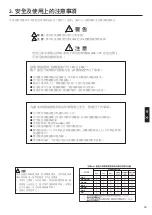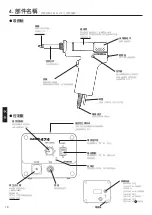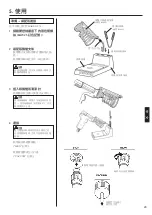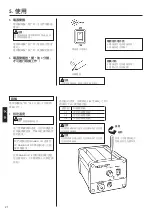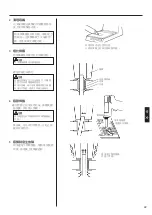
7
5. Operation
Heated solder and flux can cause oxides to form and adhere to the nozzle and the
inside of the heating element. These oxides not only lower the heat conductivity, but
can also clog the nozzle and heating element, resulting in a drop in suction efficiency.
Should there be a noticeable drop in suction efficiency during operation, replace the
filter and clean the nozzle and heating element with the provided cleaning pin.
Cleaning during Operation
1. Observing the indicator
While looking at the indicator and
with the hole of the nozzle open,
pull the trigger and look at the in-
dicator. If it is red, clean the nozzle
and heating element, empty the
filter pipe, and replace the filters. If
the indicator is blue, cleaning is not
necessary and operations can be
resumed.
CAUTION
The indicator will not operate accurately if
the hole of the nozzle is closed or if the sol-
der in the hole of the P.W.B. is not melted.
CAUTION
The indicator on the HAKKO 475 reads
in a different way.
For instruction on the reading the
HAKKO 475 indicator, please refer to
the HAKKO 475 instruction manual.
2. Replacing the filter
Replace the filter as shown 1 to 3.
During operation, the filter pipe is
very hot. Wait until the filter pipe is
cool before replacing the filter.
We recommend keeping a second
filter pipe containing new filters han-
dy, and replacing the installed filter
pipe with this backup filter pipe.
3 Replace the entire filter pipe
with he provided backup filter pipe.
2 Pull
1 Down
Normal
Blue or slight
amount of red
can be seen.
Abnormal
More than half
of the indicator
is red.
Solution
If the indicator is more than
half red, replace the filter
and clean the nozzle and
the inside of the heating
element.
(refer to p.12 Maintenance
of the Desoldering Gun)
CAUTION : If there is a noticeable drop in suction
efficiency, clean the nozzle and heating ele-
ment with the cleaning pin.
Problems during Desoldering
A. The solder in the junction is
not sufficiently melted.
B. Suction power is dropping.
A. The solder in the junction is not sufficiently melted.
l
Temperature is not high enough
The following parts require a greater heat capacity to desolder.
• Multilayer P.W.B.s, power supplies, ground planes in through-hole
P.W.B.s, high-capacity transistors, triacs with heat radiation fins, tuner
P.W.B. ground wires, and large-scale transformer terminals.
Use a preheating oven or heating gun to heat the P.W.B. to a temperature that
won’t damage the board or its components [between 70°C (160°F) and 80°C (180
°F)], then desolder. Do not increase the temperature of the gun by recalibration
as this may damage the P.W.B. and its components.
l
Nozzle is worn out.
• When the nozzle begins to wear out, the heating efficiency begins
to decline. Check the nozzle. If the solder plating is damaged, or the
nozzle is eroded, replace the nozzle. (refer to p.9)
English
Summary of Contents for 474
Page 19: ...3 18 1 2 M4 25 380 480 HAKKO...
Page 21: ...20 5 B1094 B1095 HAKKO 474 1 M4 25 2 3 4 IRON VACUUM...
Page 22: ...21 1 2 1 2 5 6 3 5 3 1 HAKKO 191 HAKKO 192 HAKKO 474 380 480 1 2 3 4 5 6...
Page 23: ...22 2 3 4 5...
Page 24: ...23 1 HAKKO 475 HAKKO 475 HAKKO 475 2 1 3 3 2 1 A B A 70 80 25 25 5 25...
Page 25: ...24 HAKKO 474 B 25_26 20 25 26 24 20 28 a b c d e f...
Page 26: ...6 25 HAKKO 474 1 2 3...
Page 27: ...26 6 A1033 A1033 4 A1033 5...
Page 28: ...27 1 A1009 2 1 2 3 A1009 S20 6 VACUUM...
Page 29: ...28 7 23 2 4 1 2 3 4 24V 50W 5 1 3 CAL 380 CAL...


